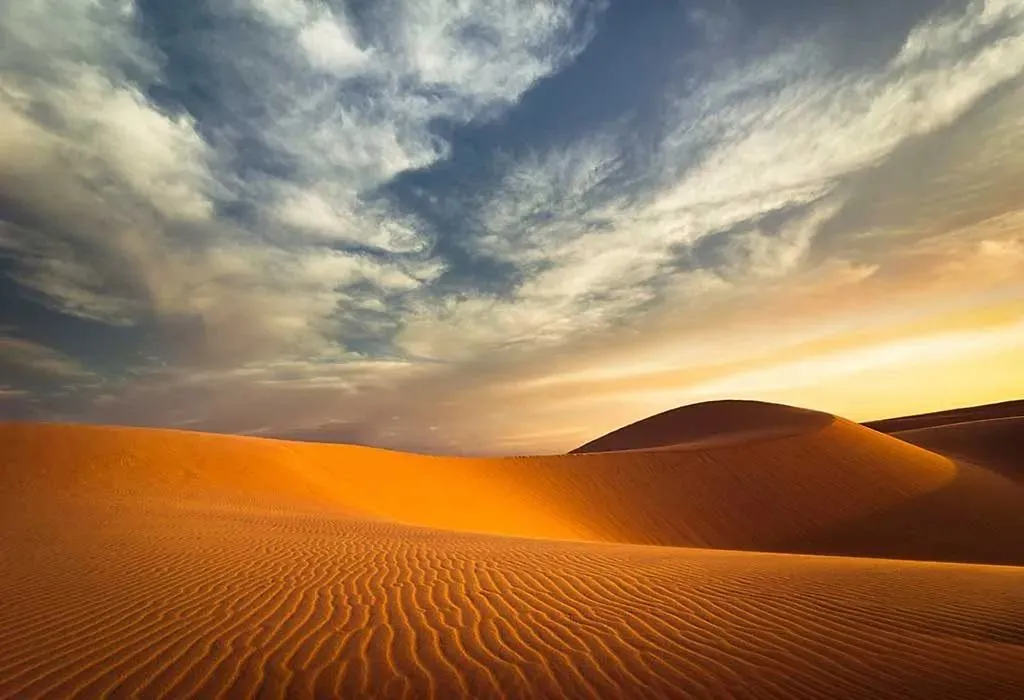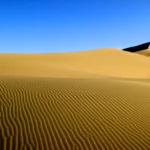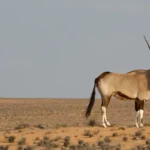Get ready to explore the wonders of the desert! From the towering sand dunes to the scorching temperatures, these fascinating landscapes are full of unexpected surprises. Join us as we uncover the secrets of the desert, from the animals that have adapted to survive in this harsh environment to the geological formations that tell the story of time. So, strap yourself in, grab your sense of curiosity, and let’s go on an adventure through the desert!
Fun Facts About the Desert
Picture this: a vast expanse of sand and rock, baking under the relentless sun. That’s a desert in a nutshell! These amazing landscapes receive less than 10 inches of rain each year – talk about dry spells! This lack of moisture makes the ground incredibly parched, allowing the wind to easily sculpt magnificent dunes and canyons.
But hey, it’s not all about sand and wind. Deserts are full of surprises! For starters, the searing heat can be deceiving. While the Sahara Desert might hit a sizzling 40°C (that’s over 100°F!) during the day, nighttime temperatures can plummet dramatically, sometimes even dipping below freezing.
Speaking of surviving the extremes, desert critters have gotten pretty creative. Many animals are nocturnal, meaning they come out to play under the cool cover of darkness, avoiding the sun’s intense rays. Talk about beating the heat!
Now, you might think all deserts are scorching wastelands, but think again! Did you know that deserts can be hot and dry, semiarid (a little more forgiving), coastal (think ocean breezes!), and even cold (Antarctica, anyone)? It just goes to show, the desert is a land of unexpected diversity!
And let’s not forget about the most extreme temperature record-holder: Death Valley in the United States. This place once hit a mind-blowing 134°F – that’s hot enough to fry an egg on the sidewalk!
Fun Facts Summary
| Fact | Description |
|---|---|
| Dry as a Bone! | Less than 10 inches of rain falls annually. |
| Wind Sculpted Wonders | Dry soil + strong wind = constantly changing landscapes! |
| Sahara Sizzle | Daytime temperatures in this desert often exceed 40°C. |
| Record-Breaking Heat | Death Valley: Home to the highest temperature ever recorded on Earth (134°F)! |
| Creatures of the Night | Many desert animals are nocturnal to escape the heat. |
| Desert Variety Pack | Deserts come in different types, including hot, cold, coastal, and semiarid. |
| Extreme Temperature Swings | Daytime highs can be scorching, but nights can get surprisingly chilly. |
For those intrigued by the arid expanse of the desert, you can quench your curiosity with a range of trivia tidbits available in our desert trivia section.
Dancing with the Sun: How Desert Life Thrives in Extreme Heat
We’ve seen how tough deserts can be, but what’s truly amazing is how plants and animals there don’t just survive, they thrive. It’s like they’ve learned the secret handshake of the desert, adapting in incredible ways to handle the scorching heat. Let’s dive into their world and see how they do it.
Turning Up the Heat (and Hiding From It)
Imagine trying to live in a furnace. That’s the reality for desert animals. Their first trick? Avoiding the worst of it. When the sun’s blazing, they’re chilling out in burrows, caves, or even just finding a shady spot under a bush. It’s all about staying cool and conserving energy. And some animals are like little desert vampires, coming alive at dawn and dusk when it’s cooler, These “crepuscular” critters have figured out that the best time to party is when the sun’s taking a break.
Built for the Burn
Not only do desert animals behave differently, but their very bodies are designed for the heat. Many have light-colored coats or skin, acting like natural sun umbrellas to reflect away those intense rays. And those long, lean limbs you often see? Think of them as built-in radiators, helping to dissipate heat and keep things cool. Some animals even have special hairs or skin that act like insulation, providing extra protection from the sun’s wrath.
Lizard Wizards and Sleeping Champions
Deserts are home to some seriously cool customers – literally! Desert lizards, for instance, are masters of temperature control. They’ll bask in the sun to warm up, then scurry to the shade when they need to cool down. Talk about having your cake and eating it too! Other animals have a more extreme approach. When the going gets tough, they go into “estivation,” which is like a deep sleep that helps them ride out extreme heat and drought. It’s like hitting the pause button on life until things get better.
A Land of Adaptation, for Plants Too!
It’s not just animals that have adapted to the desert; plants have had to evolve some impressive tricks as well. Since water is scarce, they’ve become masters at holding onto every precious drop. Thick, waxy leaves act like shields, preventing water loss, while their extensive root systems spread out like thirsty explorers, seeking out any moisture hidden beneath the surface. They’ve turned themselves into living, breathing water towers!
Deserts may seem harsh and unforgiving, but they are a testament to the resilience of life. From clever behaviors to unique physical adaptations, desert dwellers have shown us that life finds a way, even in the most extreme environments.
Silent Symphony: Exploring the Unique Flora and Fauna of the Desert
We’ve already talked about how tough desert life can be, but what’s really amazing is how plants and animals not only survive, but thrive in this challenging environment. It’s like a secret code they’ve cracked, adapting in incredible ways to handle the heat and lack of water. Think of it as nature’s ultimate survival guide playing out right in front of us.
Take cacti and succulents, for example. They’re the ultimate water hoarders! Their thick, waxy skin is like a built-in water bottle, and their smaller leaves mean less water loss. They’ve even figured out how to soak up carbon dioxide at night with something called CAM photosynthesis, making them super-efficient in the water department.
But it’s not just the plants showing off their survival skills. Desert animals are just as impressive! Those big ears on a Fennec fox aren’t just adorable; they’re like personal air conditioners, helping them stay cool. And their sandy fur? It’s the perfect camouflage to blend into the desert landscape, keeping them safe from predators. Then there are dune lizards, the ultimate sunbathers, shifting between shade and sun to regulate their body temperature like pros.
What’s even cooler is how everything works together in the desert. Think of it like a delicate dance. Scorpions and tarantulas might seem scary, but they’re essential for keeping things in check by controlling insect populations. High above, majestic eagles soar, keeping an eye out for rodents and keeping their numbers balanced. It’s a delicate web of life where every creature plays a vital role.
Now, here’s where we come in. It’s our job to protect these incredible desert ecosystems. By safeguarding water sources, stopping invasive species, and reducing pollution, we’re giving desert plants and animals a fighting chance. And by making smart choices when we’re exploring these fragile environments, we can all do our part to keep this silent symphony playing for generations to come.
Remember, deserts might seem silent, but they’re teeming with life that never ceases to amaze.
Sculpted by Time: Unraveling the Geological Wonders of Desert Landscapes
We’ve already talked about how amazing deserts are, but let’s dive even deeper into how these awesome landscapes came to be! Imagine a painter, but instead of brushes, it’s wind and rain, and the canvas is the Earth itself. That’s what’s been happening in deserts for millions of years, creating everything from flat plains to towering dunes.
Take the White Desert in Egypt – it’s like walking through a dream! Imagine giant, white chalk sculptures scattered across the landscape, sculpted by the wind and the slow, steady movements of the Earth’s crust. Then you have the Sahara Desert, home to the mysterious Richat Structure. This massive, circular formation looks like a giant bullseye from above. Scientists are still trying to figure out exactly how it formed, making it a true enigma of the desert.
But deserts are more than just sand and rocks. They’re teeming with unique plants and animals that have figured out how to thrive in these challenging environments. And then there are the mirages, shimmering illusions that play tricks on your eyes – making you wonder what’s real and what’s not!
Artists are also drawn to the desert’s magic, finding inspiration in its raw, natural beauty. Events like Desert X AlUla showcase incredible art installations that blend seamlessly with the environment, making us think about our relationship with nature and highlighting the cultural importance of these landscapes.
But deserts are also playgrounds for adventurers! Picture yourself sandboarding down a giant dune, feeling the wind in your hair. Or imagine trekking across the desert on a camel, following ancient caravan routes. And let’s not forget about the lost cities and ancient ruins hidden beneath the sand, just waiting to be discovered. Each adventure reveals another layer of the desert’s captivating story, connecting us to the power and beauty of the natural world.
FAQ
Q1: What is the most interesting fact about deserts?
A1: The highest temperature ever recorded on Earth was in Death Valley, a desert in California and Nevada, at 134°F (56.7°C).
Q2: How do animals survive in the desert?
A2: Desert animals have evolved unique adaptations to cope with extreme heat, limited water, and sparse vegetation. Many are nocturnal, active only at night, and some have specialized body structures and behaviors that help them conserve water and energy.
Q3: What are some unique desert landscapes?
A3: Deserts exhibit diverse landscapes shaped by geological processes and climatic conditions. These include salt flats, sand dunes, rocky outcrops, and dry riverbeds, each with its distinct characteristics and ecological significance.
Q4: How do plants survive in the desert?
A4: Desert plants have adapted to the arid conditions through various strategies. They often have deep root systems to access underground water sources, thick leaves or stems to store water, and specialized leaf structures that reduce water loss through transpiration.
Q5: What is an unusual desert phenomenon?
A5: Mirages are fascinating optical illusions that occur in deserts due to temperature differences between the ground and the air. They create the appearance of distant water bodies or objects, which can be both mesmerizing and deceptive for desert travelers.
- Discover Long Black Pepper: Flavor & Health Benefits - April 25, 2025
- Shocking Twists: The Grownup Review: Unreliable Narration - April 25, 2025
- A Quiet Place Book vs Movie: A Deep Dive - April 25, 2025
















